
Giftpia, stylized as GiFTPiA, is a video game, developed by Skip Ltd. for the GameCube. It was released in Japan on April 25, 2003. Nintendo cancelled the North American localization of Giftpia. In English, the game would most likely be better understood as called "Giftopia" to represent the two words, gift and utopia.

Nintendogs is a real-time pet simulation video game developed and published by Nintendo for the Nintendo DS handheld video game console. It was released in Japan, and was later released in: North America, Australia, New Zealand, Europe and other regions. It was originally released in three different versions: Dachshund & Friends, Lab & Friends and Chihuahua & Friends. It has been re-released twice, first as a bundled release with a special edition Nintendo DS with a new version called Nintendogs: Best Friends and later as Nintendogs: Dalmatian & Friends.
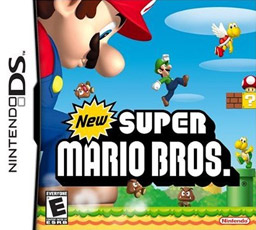
New Super Mario Bros. is a 2006 platform video game developed and published by Nintendo for the Nintendo DS. It was first released in May 2006 in North America and Japan, and in PAL regions in June 2006. It is the first installment in the New Super Mario Bros. subseries of the Super Mario franchise, and follows Mario as he fights his way through Bowser's henchmen to rescue Princess Peach. Mario has access to several old and new power-ups that help him complete his quest, including the Super Mushroom, the Fire Flower, and the Super Star, each giving him unique abilities. While traveling through eight worlds with more than 80 levels, Mario must defeat Bowser Jr. and Bowser before saving Princess Peach.
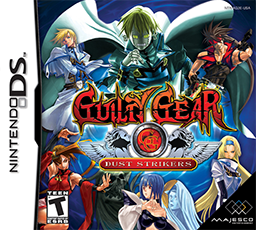
Guilty Gear: Dust Strikers, or Guilty Gear DS, is a fighting game of the Guilty Gear series for the Nintendo DS. Modeled after Guilty Gear Isuka, its gameplay allows up to four player fights. It was the first versus fighting game for the Nintendo DS to be released outside Japan.

Brain Age: Train Your Brain in Minutes a Day!, known as Dr. Kawashima's Brain Training: How Old Is Your Brain? in PAL regions, is an edutainment puzzle video game. It was developed and published by Nintendo for the Nintendo DS. Nintendo has stated that it is an entertainment product inspired by Tohoku University professor Ryuta Kawashima's work in the neurosciences.

Chibi-Robo! Plug Into Adventure! is a platform-adventure video game developed by Bandai and Skip Ltd. and published by Nintendo for the GameCube console. It was released in Japan in 2005, and in North America and Europe the following year. Originally conceived as a point-and-click adventure game, it was put on developmental hold until Nintendo producer Shigeru Miyamoto gained interest in the title and overhauled its production.

Skip Ltd. is a Japanese video game developer that has a close relationship with Nintendo. Nintendo has published all of their Japanese releases; with the only notable exception being LOL, which skip Ltd. published independently. The company's staff includes prominent developers from Square such as Kenichi Nishi and Keita Eto. In October 2019, it was reported by OneControllerPort.com that the company had changed its name to Skip Inc. the previous year and had become inactive on all social media. By August 2020, it was reported that the company may have become defunct as they hadn't released a game since 2015, however this has not yet been officially confirmed.

The Legend of Zelda: Phantom Hourglass is an action-adventure game developed and published by Nintendo for the Nintendo DS handheld game console. It is the fourteenth installment in The Legend of Zelda series and the direct sequel to the 2002 GameCube title The Wind Waker. Phantom Hourglass was released worldwide in 2007, with the exception of South Korea in April 2008. The game was re-released for the Wii U via the Virtual Console service in the PAL region in November 2015, in North America in May 2016, and in Japan in August.

Yoshi's Island DS, known in Japan as Yoshi Island DS, is a 2006 platform game developed by Artoon and published by Nintendo for the Nintendo DS. It was released in North America and Australia in November 2006, in Europe in December 2006, and in Japan in March 2007. It is a sequel to the 1995 SNES game, Super Mario World 2: Yoshi's Island. Announced at Nintendo's E3 press conference in May 2006, the game was well received by critics, scoring an average of 81% on Metacritic's aggregate. The game was originally to be titled Yoshi's Island 2, though its name was changed one month before its North American release. In April and May 2015, the game was made available for the Wii U via the Virtual Console service, shortly after a Nintendo Direct presentation.

Vanpool, Inc. was an independent Japanese video game, music software, computer software and toy developer. Its employees included Taro Kudou and Kazuyuki Kurashima, both of whom worked for the independent game developer Love-de-Lic. The company shut down on May 31, 2023.

Professor Layton and the Curious Village is a puzzle adventure video game for the Nintendo DS system. It was developed and published by Level-5 in Japan and published by Nintendo worldwide. It was released in Japan in 2007 and worldwide the following year. It was re-released in Australia using the British English localisation and European artwork to replace the previously released North American localisation. Curious Village is the first game in the Professor Layton series, followed by Professor Layton and the Diabolical Box. An enhanced mobile port of Curious Village featuring additional cutscenes, subtitled "HD for Mobile", was released in 2018.

MySims is a video game developed by EA Redwood Shores and published by Electronic Arts as a spin-off to Maxis' The Sims franchise for the Wii and Nintendo DS in September 2007, re-released for Microsoft Windows and mobile phones in 2008, and for BlackBerry in 2009.
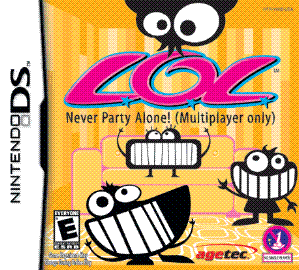
LOL, known in Europe as Bakushow and in Japan as Archime DS, is a Nintendo DS video game. The game was published by Skip Ltd. in Japan, Agetec in North America, and Rising Star Games in Europe. Developed by a group of five people headed by Kenichi Nishi, LOL is a multiplayer game implemented with a PictoChat-like interface in which a host player asks a question, requiring others to write or draw their answers on the DS touchscreen.

Kingdom Hearts 358/2 Days is an action role-playing video game developed by h.a.n.d. and Square Enix in collaboration with Disney Interactive Studios for the Nintendo DS. It is the fifth installment in the Kingdom Hearts series, and takes place near the end of the first game in parallel to Kingdom Hearts: Chain of Memories, leading directly into the events of Kingdom Hearts II. The game was released worldwide in 2009. The story is told from the perspective of Roxas, and follows his daily life within Organization XIII and his relationship with fellow Organization member Axel; it also introduces a fourteenth member, Xion, who befriends them.

NOISE Inc. is a Japanese video game development company that works in partnership with Nintendo, developing games for the Custom Robo series.

Pokémon Platinum Version is a 2008 role-playing video game developed by Game Freak and published by The Pokémon Company and Nintendo for the Nintendo DS handheld game console. It is the third version after Pokémon Diamond and Pearl and is part of the fourth generation of the Pokémon video game series. It was released in Japan on 13 September 2008, and later in North America, Australia, and Europe in 2009.
Kenichi Nishi is a Japanese video game designer. He has helped found a number of notable video game companies and develops games at Route24, his own private limited company. The number 24 in the title comes from its founder's name: "Ni" (2) and "Shi" (4).
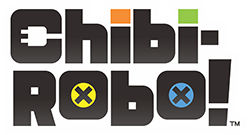
Chibi-Robo! is a series of adventure video games developed by Skip Ltd. and published by Nintendo. The franchise follows a series of tiny robotic units known as Chibi-Robo, whose purpose is to spread Happiness. Recurring game elements of the franchise include monitoring Chibi-Robo's battery usage at all times, and cleaning Chibi-Robo's nearby environment through a variety of methods in order to collect "Happy Points," the game’s collectible representation of the happiness you instill in others. While the primary purpose of a Chibi-Robo is to assist humans, they have also been shown to assist animals, sentient alien life, and even living toys.
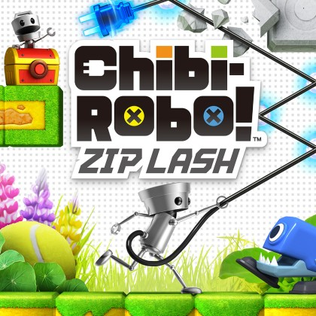
Chibi-Robo! Zip Lash is a 2015 side-scrolling platform game developed by Skip Ltd. and Vanpool and published by Nintendo for the Nintendo 3DS. It is the fifth installment in the Chibi-Robo! series, and the second Chibi-Robo! game for the 3DS after Chibi-Robo! Photo Finder (2014). Zip Lash players control the character Chibi-Robo, a robot that is tasked with roaming the world and defending its natural resources from a fleet of invading aliens. Chibi-Robo is equipped with a cord and plug with which he can attack enemies and get to inaccessible places. Throughout the levels, the player can find collectibles such as big coins, Chibi-Tots, and snacks that are based on real-world brands.


















